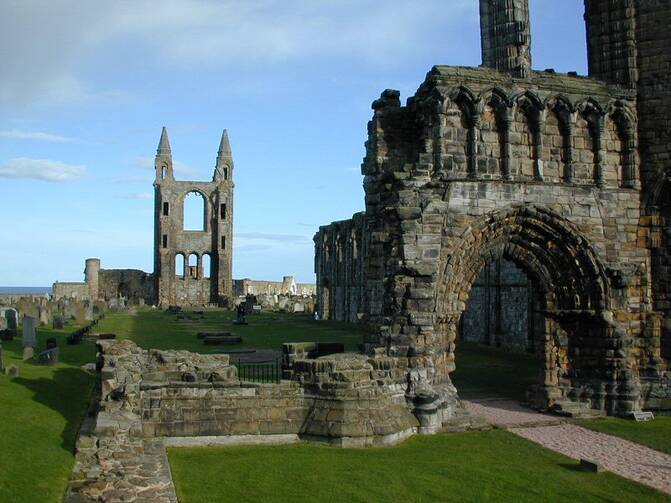It is hard to get away from campus during the semester, and the end of September is a busy time at Harvard. Nevetheless, I have traveled to St Andrews, on the Northeast coast of Scotland, for a series of events marking the completion of a “Year of Interfaith Dialogue” hosted by Professor Mario Aguilar at the venerable St Andrews University, founded in 1413. Aguilar, a Camaldolese Benedictine hermit in the Benedictine tradition is the director of the Centre for the Study of Religion & Politics and a well-known figure in the world of interfaith relations. He is the author of many books, including a recent biography of Pope Francis, Pope Francis: His Life and Thought, 2014.
The main event on Sept. 23 was the signing of the “Declaration on a Shared Humanity,” which you can read here. This set of 11 statements is designed not so much to break new ground theologically, but to gather individuals and their communities together in the work of peace, dedicating themselves to cooperative efforts toward interreligious understanding. The latter part of the statement is given over to testimonies from several traditions, meant to demonstrate that each tradition does have a spiritual instinct toward mutual respect and understanding.
Well over 100 signers were present, ranging from distinguished senior religious leaders to three children. Some signers, such as the Dalai Lama, had signed earlier in the year. Pope Francis, it is said, watched the live-stream of the signing. Near the end of the ceremony, in a particularly moving moment, a young woman who was a survivor of the slaughter of 77 young people in Norway on the island of Utøya read a poem testifying to the stubborn resistance of the human spirit to violence. She previewed her poem with a brave claim: if one man could do such harm in so short a time, how much good can we do in the long term, working together!
On Friday afternoon, there was a book release celebrating Mario Aguilar’s Christian Ashrams, Hindu Caves, and Sacred Rivers: Christian-Hindu Monastic Dialogue in India 1950-1993. This book—a reflective combination of history, theological reflection, and constructive proposals about the future of interfaith spirituality—tells the story of the Western spiritual pioneers who founded ashrams in India: Francis Mahieu (founder of the Kurisumala Ashram in Kerala), Henri Le Saux (who with Jules Monchanin founded Shantivanam in Tamil Nadu), Bede Griffiths (the life and soul of Shantivanam for a generation) and the charismatic theologian and prophet of spiritual interfaith learning, Raimon Panikkar. While their spiritual contributions are but one part of the story of India's Christian identity today, it seems to me that such figures did great good with slender means.
Friday evening I was honored to give the opening address for the academic conference, “Interreligious Words: Before—and After—Silence.” While honoring the instinct of many spiritual practitioners toward silence as a best form of spiritual communion, I made the case for the holiness and intellectual substance of the many words of the Hindu and Christian traditions: speech and thinking too are holy and need not be put aside entirely for the sake of silence and pure experience.
On Saturday, the academic conference progressed with the presentation of eight papers on diverse themes related to the spirituality of interreligious exchange. Some stressed silence, others work for justice; some saw the work as breaking new ground; others, as retrieving wisdom deep in the traditions.
It was clear to me that the many energies present in the papers would have a fuller impact if we all kept listening to one another: Experience alone is not enough to insure that individuals and communities are alive spiritually; words without silence will fall short; silence that bars thinking entirely is only for a few; the work of justice can become too angry if we do not also find ways to respect and love our imperfect traditions; finding wisdom in our traditions can be suffocating if nothing new is allowed to emerge.
All of this was quite impressive, a testimony to the commitment of Mario Aguilar and his colleagues to seeking out a deep spirituality that can bring people together rather than divide them and build spiritual communities that work for peace and justice throughout the world.
Very much also to the point, it struck me that these events were all the more impressive because they occurred at St Andrews. At the time of the Reformation, this university town saw more than its share of religious violence. There are crosses in stone in the street at four or more places, marking where proponents of the Reformation were burned alive. In March, 1546 George Wishart was burned alive outside St Andrews Castle; several months later, his supporters took over the castle and eventually killed Cardinal Beaton who had ordered the execution.
French bombardment during a long siege then destroyed much of the castle, which stands in ruins today. Not far away are the ruins of the great medieval abbey and cathedral, partly destroyed a few years later, also left then to fall into ruin. Such ruins are hauntingly beautiful and yet too simply haunting as reminders of the bloodshed and persecutions not very distant in the Christian past.
While not all readers will be at ease with the pace of new movements toward interreligious understanding today, it would be very hard indeed to argue that things have not changed for the better: interreligious work for peace and mutual respect has replaced violent efforts to have one religion conquer all others. St Andrews today is a beacon of respect and peace, where once fire and blood had dominated the religious scene.
I will post one more entry before my brief trip to Scotland ends, after my visit to Edinburgh on Sept. 25-27.







